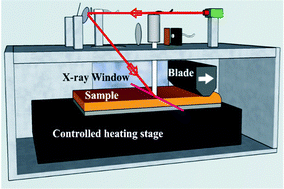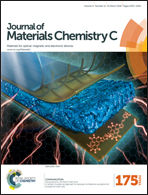Real-time evaluation of thin film drying kinetics using an advanced, multi-probe optical setup†
Abstract
Solution-processed organic photovoltaic devices are advantageous due to their low-cost large area manufacturing techniques, such as slot-die coating, gravure printing and roll-to-roll coating. The final microstructure of a polymer:fullerene bulk-heterojunction (BHJ) film is a fine interplay between solution thermodynamics (e.g. solubility, miscibility…) and kinetics (e.g. solvent evaporation, polymer ordering, phase separation…) during the drying process. In order to design better performing organic photovoltaic devices, gaining knowledge over the drying properties of polymer:fullerene thin films is essential. A novel in situ thin film drying characterization chamber, equipped with white-light reflectometry, laser light scattering and photoluminescence, is presented in combination with grazing-incidence X-ray diffraction on two different polymer:fullerene bulk heterojunctions based on poly-(3-hexylthiophene-2,5-diyl) (P3HT) and polythieno[3,2b]thiophene-diketopyrrolopyrrole-co-thiophene (DPP-TT-T) polymers. With photoluminescence applied for the first time as an in situ method for such drying studies, these single-chamber measurements track the fine interplay between thermodynamics and kinetics of thin film drying and provide invaluable information on solution behavior and microstructure formation.


 Please wait while we load your content...
Please wait while we load your content...